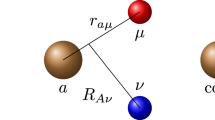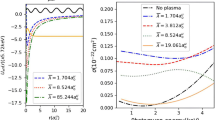Summary
Some aspects of the cascade of neutral exotic atoms are analysed. In particular the relevance of the Coulomb de-excitation—transitions induced by the Coulomb interaction with the surrounding atoms—is pointed out. Cross-sections and rates are calculated for μ−p and π−p atoms in hydrogen with energies ranging between 0.1 and 10 eV. The effect turns out to be dominant forn≳10 and for a large interval of pressure values. The consequence is a drastic shortening of the early stages of the cascade. When considered for π−p atoms, the effect provides a better agreement between the theoretical and experimental cascade times than that previously found.
Riassunto
Si analizzano alcuni aspetti della cascata di atomi esotici neutri. In particolare, si mette in rilievo l’importanza della deeccitazione Coulombiana (transizioni indotte dall’interazione Coulombiana con gli atomi circostanti). Si calcolano le sezioni d’urto e le velocità di decadimento per atomi μ−p e π−p nell’idrogeno, per energie comprese fra 0.1 eV e 10 eV. L’effetto risulta predominante pern≳10 e per un grande intervallo di valori della densità. Di conseguenza, i primi stadi della cascata richiedono un tempo sensibilmente più breve. Nel caso di atomi π−p, tenendo conto di questo effetto si migliora l’accordo fra il valore teorico e quello sperimentale del tempo di cascata.
Реэюме
Аналиэируются некоторые аспекты каскада нейтральных зкэотичеслих атомов. В частности, отмечается роль кулоновского снятия воэбуждения, т.е. переходов, индуцированных кулоновским вэаимодействием с окружаюшими атомами. Вычисляются поперечные сечения и интенсивность обраэования μ−p и π-р атомов в водороде в области знергий от 0.1 до 10 зВ. Окаэывается, что зффект кулоновского снятия воэбуждения доминирует дляn≳10 и в больщом интервале эначений давления. Вследствие зтого отмечается сушественное сокрашение ранних стадий каскада. Для π-р атомов рассмотренный зффект обеспечивает лучщее согласие между теоретическим и зкспериментальным временем каскада, чем сообшалось ранее.
Similar content being viewed by others
References
See, for instance,J. B. Warren, Editor:Nuclear and Particle Physics at Intermediate Energy, NATO Advanced Study, Vol.15, Series B (New York, N. Y., 1976);G. Fiorentini andG. Torelli, Editors:Proceedings of the First International School of Physics of Exotic Atoms, Erice, 1977, to appear.
L. C. Biedenharn andP. J. Brussaard:Coulomb Excitation (Oxford, 1965).
H. A. Bethe andM. Leon:Phys. Rev.,127, 636 (1962).
G. Kodosky andM. Leon:Nuovo Cimento,1 B, 41 (1971);R. O. Mueller, V. W. Hughes, H. Rosenthal andC. S. Wu:Phys. Rev. A,11, 1175 (1975);G. Carboni andG. Fiorentini:On the collision quenching of the 2S state of muonic hydrogen, to be published inNuovo Cimento.
H. Anderhub, F. Kottmann, H. Hofer, P. Le-Coultre, D. Makowiecki, O. Pitzurra, B. Sapp, P. G. Seiler, P. Schrager, N. Wälchl andP. Wolff:Phys. Lett.,60 B, 273 (1976).
L. D. Landau andE. M. Lifshitz:Quantum Mechanics (Oxford, 1966).
A similar approach is outlined in ref. (6), for the one-dimensional case.
A similar expansion in thenlm basis was considered byV. Milucci: Thesis, University of Pisa, unpublished (1971).
Actually a weaker condition is needed,i.e. the variation ofϱ JM 1 M 2 insideΩ should be smooth (see ref. (6), sect.48).
R. H. Pratt andJ. F. Jordan:Phys. Rev.,148, 1276 (1966).
E. C. Stueckelberg:Helv. Phys. Acta,5, 370 (1932);L. D. Landau:Žurn. Ėks. Teor. Fiz., No. 6 (1932);2, 46 (1932);C. Zener:Proc. Roy. Soc.,137 A, 696 (1932).
A. Ünsold:Physik der Stern Atmosphären (Berlin, 1955).
T. H. Fields, G. B. Yodh, M. Derrick andJ. G. Fetkovick:Phys. Rev. Lett.,5, 69 (1960).
In ref. (3) a cascade time τ″=3.5·10−12 s was obtained by advocating a rather large value (σ n ≅\(\frac{1}{2}\) πa 2 n ) of the molecular-dissociation cross-section; this process has the main effect of shortening phaseb) with respect to pure Auger decay (τ A+diss15 → 10 ==0.6·10−12). The corresponding cross-section is an order of magnitude smaller than the total cross-sections. Let us observe that the Coulomb de-excitation can lead to molecular dissociation, provided that the energy released to the H2 molecule exceeds the dissociation energy Δ=4.7 eV. Forn≳10, this requires however jumps between pion orbits with Δn⩾2. These being strongly suppressed in comparison with Δn=1 transitions, the molecular dissociation comes out to be unlikely.
Author information
Authors and Affiliations
Rights and permissions
About this article
Cite this article
Bracci, L., Fiorentini, G. Coulomb de-excitation of mesic hydrogen. Nuov Cim A 43, 9–30 (1978). https://doi.org/10.1007/BF02729003
Received:
Published:
Issue Date:
DOI: https://doi.org/10.1007/BF02729003




